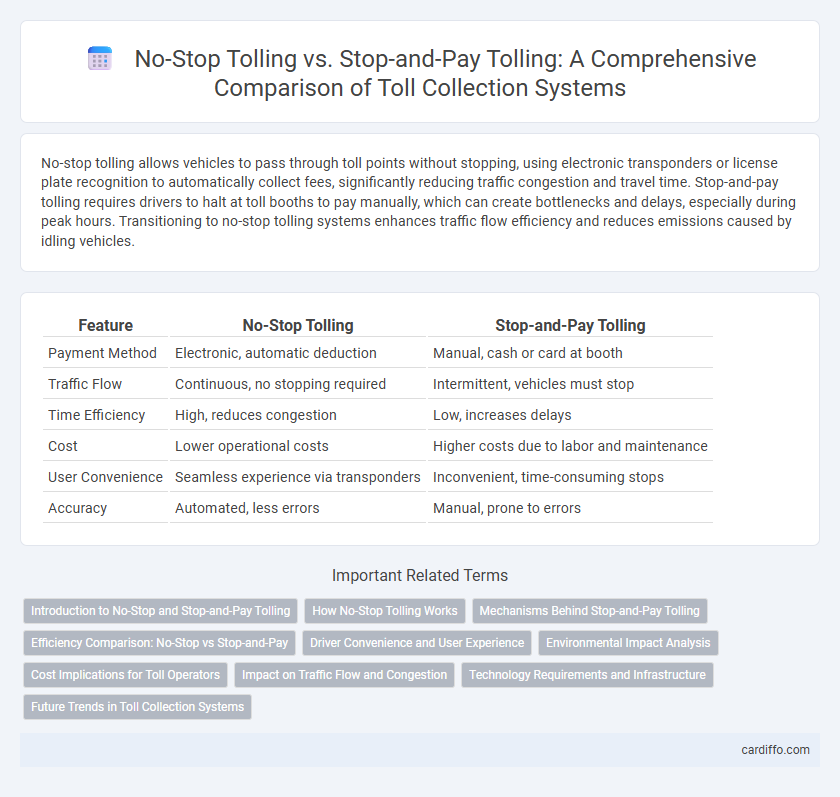No-stop tolling allows vehicles to pass through toll points without stopping, using electronic transponders or license plate recognition to automatically collect fees, significantly reducing traffic congestion and travel time. Stop-and-pay tolling requires drivers to halt at toll booths to pay manually, which can create bottlenecks and delays, especially during peak hours. Transitioning to no-stop tolling systems enhances traffic flow efficiency and reduces emissions caused by idling vehicles.
Table of Comparison
| Feature | No-Stop Tolling | Stop-and-Pay Tolling |
|---|---|---|
| Payment Method | Electronic, automatic deduction | Manual, cash or card at booth |
| Traffic Flow | Continuous, no stopping required | Intermittent, vehicles must stop |
| Time Efficiency | High, reduces congestion | Low, increases delays |
| Cost | Lower operational costs | Higher costs due to labor and maintenance |
| User Convenience | Seamless experience via transponders | Inconvenient, time-consuming stops |
| Accuracy | Automated, less errors | Manual, prone to errors |
Introduction to No-Stop and Stop-and-Pay Tolling
No-stop tolling systems use electronic sensors and transponders to automatically charge vehicles without requiring them to stop, improving traffic flow and reducing congestion. Stop-and-pay tolling requires drivers to halt at toll booths to pay manually, often causing delays and increasing the risk of accidents. Implementing no-stop tolling enhances efficiency on highways by minimizing interruptions and streamlining toll collection processes.
How No-Stop Tolling Works
No-stop tolling uses electronic sensors and transponders to automatically detect and charge vehicles as they pass through toll points without requiring them to stop. Vehicles equipped with RFID tags or license plate recognition technology are identified in real-time, allowing toll payments to be processed seamlessly. This system reduces congestion, improves traffic flow, and minimizes delays associated with traditional stop-and-pay toll booths.
Mechanisms Behind Stop-and-Pay Tolling
Stop-and-pay tolling requires vehicles to halt at a toll booth where cash or card payments are manually processed, relying on physical barriers and human operators to collect fees. This mechanism involves queuing systems and toll attendants who handle transactions, often causing delays during peak hours. Unlike electronic no-stop tolling, stop-and-pay tolling depends heavily on infrastructure like payment booths and personnel for toll collection.
Efficiency Comparison: No-Stop vs Stop-and-Pay
No-stop tolling systems use electronic transponders and automatic license plate recognition to eliminate the need for vehicles to slow down or stop, significantly reducing congestion and travel time on highways. In contrast, stop-and-pay tolling requires vehicles to halt at toll booths, increasing delays, fuel consumption, and emissions due to idling and acceleration. The efficiency gains of no-stop tolling are supported by studies showing up to a 30% reduction in travel time and improved traffic flow compared to traditional stop-and-pay methods.
Driver Convenience and User Experience
No-stop tolling enhances driver convenience by allowing vehicles to pass through toll points without halting, reducing travel time and minimizing traffic congestion. This system leverages electronic toll collection technology, such as RFID tags or license plate recognition, to automatically charge tolls, providing a seamless user experience. In contrast, stop-and-pay tolling requires drivers to stop and manually pay, increasing wait times and disrupting traffic flow, which can lead to frustration and delays.
Environmental Impact Analysis
No-stop tolling systems reduce vehicle emissions by eliminating the need for vehicles to stop and idle at toll booths, leading to improved air quality and lower greenhouse gas emissions. Studies indicate that no-stop tolling can cut carbon emissions by up to 70% compared to traditional stop-and-pay tolling, as vehicles maintain constant speeds and avoid the fuel-wasting acceleration and deceleration cycles. Implementing electronic toll collection also decreases noise pollution and enhances traffic flow efficiency, contributing to a more sustainable transportation infrastructure.
Cost Implications for Toll Operators
No-stop tolling systems reduce operational costs for toll operators by eliminating the need for manual toll collection and minimizing traffic congestion, leading to improved fuel efficiency and lower emissions. Stop-and-pay tolling incurs higher labor and infrastructure expenses due to staffing toll booths and maintaining payment equipment, as well as increased costs related to traffic delays and vehicle idling. Investing in electronic toll collection technologies enhances revenue collection accuracy and decreases overhead, ultimately providing better cost efficiency for toll operators.
Impact on Traffic Flow and Congestion
No-stop tolling systems use electronic transponders to automatically deduct fees, significantly reducing traffic bottlenecks and improving flow compared to stop-and-pay tolling, where vehicles must halt to pay manually. The elimination of toll plazas in no-stop tolling minimizes congestion by allowing continuous vehicle movement, leading to reduced travel times and lower emissions. Studies show no-stop tolling can increase highway capacity by up to 30%, directly mitigating traffic delays during peak hours.
Technology Requirements and Infrastructure
No-stop tolling relies on advanced electronic toll collection systems such as RFID transponders and automatic license plate recognition cameras that enable vehicles to seamlessly pass through toll points without stopping. This technology requires extensive sensor networks, real-time data processing centers, and robust communication infrastructure to ensure accurate billing and enforcement. In contrast, stop-and-pay tolling demands physical toll booths staffed with personnel or automated payment machines, necessitating larger roadway space, increased maintenance, and potential traffic congestion points.
Future Trends in Toll Collection Systems
Future toll collection systems emphasize no-stop tolling to enhance traffic flow and reduce congestion on highways. Advances in electronic toll collection technology, such as RFID and satellite-based systems, enable seamless transactions without requiring vehicles to stop. This shift toward contactless tolling supports smart city initiatives and boosts efficiency in transportation infrastructure management.
No-Stop Tolling vs Stop-and-Pay Tolling Infographic

 cardiffo.com
cardiffo.com